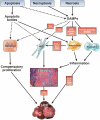Cell death and cell death responses in liver disease: mechanisms and clinical relevance
- PMID: 25046161
- PMCID: PMC4531834
- DOI: 10.1053/j.gastro.2014.07.018
Cell death and cell death responses in liver disease: mechanisms and clinical relevance
Abstract
Hepatocellular death is present in almost all types of human liver disease and is used as a sensitive parameter for the detection of acute and chronic liver disease of viral, toxic, metabolic, or autoimmune origin. Clinical data and animal models suggest that hepatocyte death is the key trigger of liver disease progression, manifested by the subsequent development of inflammation, fibrosis, cirrhosis, and hepatocellular carcinoma. Modes of hepatocellular death differ substantially between liver diseases. Different modes of cell death such as apoptosis, necrosis, and necroptosis trigger specific cell death responses and promote progression of liver disease through distinct mechanisms. In this review, we first discuss molecular mechanisms by which different modes of cell death, damage-associated molecular patterns, and specific cell death responses contribute to the development of liver disease. We then review the clinical relevance of cell death, focusing on biomarkers; the contribution of cell death to drug-induced, viral, and fatty liver disease and liver cancer; and evidence for cell death pathways as therapeutic targets.
Keywords: Alcoholic Liver Disease; Apoptosis; Caspases; Clinical Trial; DAMP; DILI; Hepatocellular Carcinoma; NASH; Necroptosis; Necrosis; Necrosome; RIP Kinases; RIP3; Viral Hepatitis.
Copyright © 2014 AGA Institute. Published by Elsevier Inc. All rights reserved.
References
-
- Fattovich G, Olivari N, Pasino M, et al. Long-term outcome of chronic hepatitis B in Caucasian patients: mortality after 25 years. Gut. 2008;57:84–90. - PubMed
-
- Iloeje UH, Yang HI, Su J, et al. Predicting cirrhosis risk based on the level of circulating hepatitis B viral load. Gastroenterology. 2006;130:678–686. - PubMed
-
- Tai DI, Lin SM, Sheen IS, et al. Long-term outcome of hepatitis B e antigen-negative hepatitis B surface antigen carriers in relation to changes of alanine aminotrans- ferase levels over time. Hepatology. 2009;49:1859–1867. - PubMed
-
- Tseng TC, Liu CJ, Yang HC, et al. High levels of hepatitis B surface antigen increase risk of hepatocellular carci- noma in patients with low HBV load. Gastroenterology. 2012;142:1140–1149.e3. quiz e13–e14. - PubMed
-
- Ghany MG, Kleiner DE, Alter H, et al. Progression of fibrosis in chronic hepatitis C. Gastroenterology. 2003;124:97–104. - PubMed
Publication types
MeSH terms
Substances
Grants and funding
LinkOut - more resources
Full Text Sources
Other Literature Sources
Medical
Miscellaneous




